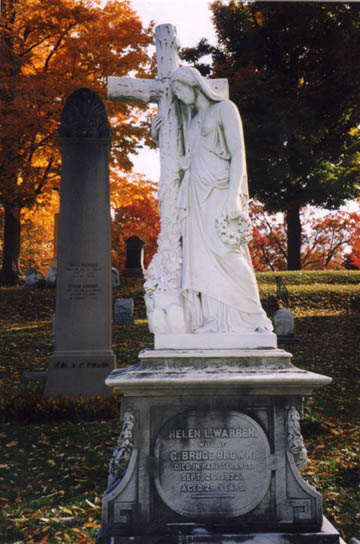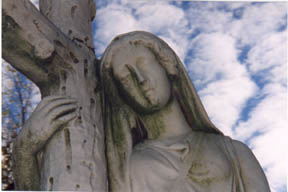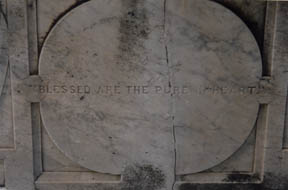
|
|

Helen Warren died on Sept 26 1872. She was in Paris, France at the time and died from typhoid fever. Typhoid fever is an acute generalized infection caused by Salmonella typhosa. The infection is spread commonly through contaminated water or milk and food handlers who are carriers. Symptoms include high fever, rose-colored spots on the abdomen and chest, and diarrhea or constipation. Going untreated, typhoid can cause death. The disease today is treatable with a simple antibiotic. She probably contracted it one to three weeks before her death. She could have contracted typhoid as early as three months prior to her death. Seeing as she died apart from her husband I feel that her death was quick, not allowing her to return home with her husband. She was married to G. Bruce Brown. She was buried on Oct 22 1872 in Mount Hope Cemetery in her family plot where her brother, mother, and father would be buried soon after. Her tomb is located in Plot 111- 112 C.
The tomb stone stands very tall about 10 feet. It is a monument of Mary Magdalene clinging to a rough cross. Mary is seen holding a wreath of laurel. Beneath the cross is a placard that says:
Wife of
G. Bruce Brown
Died in Paris France
Sept 26 1872
Aged 29 years
And on the back of the plaque is the biblical quote "Blessed are the Pure in Heart" from Matthew 5:8 and The Sermon on the Mount. On either side of the placard are strands of several different flowers. Each of these symbols on her tomb represents different feelings her husband may have felt at the time the tomb was erected.
 |
 |
The statue has many beautiful flowers, some of which are hard to decipher. One prominent flower is the cultivated rose, which often symbolizes everlasting and eternal love. Her husband in choosing this flower felt extreme love for his wife. Some of these roses appear to not be fully blossomed. This can represent a life that was cut short. As she died 29 years of age, that is possible. Another symbol of life cut short is the cut stump of a tree, which is seen in this monument at the bottom of the cross at Mary's feet. Another flower of youth and love and affection is the morning glory. This flower is rare in that it shrivels up over night giving it a dead look, and in the morning the flower blooms giving the appearance of the flower coming back to life or resurrection. Other symbols of resurrection such as the wild rose, and the anemone are also seen on this monument.
 |
 |
In Mary's hand on the tomb is a wreath. This wreath contains several different symbols. A wreath in general is a mark of triumph and distinction. Among the wreath there is laurel which is the known for reward and victory. There is also holly mixed in with the wreath, marked by the berries and the sharp edges of the leave. Holly is a symbol of passion, happiness and friendship. Perhaps this reveals, how her husband felt about her in her life, and continued into her after life. Holly is also poisonous if the berries are ingested, and this may allude to her death of typhoid where one gets violently ill. Also in the bouquet of flowers is what seems to be evening primroses, which portray lasting love and eternal remembrance. Also among the many flowers are rosettes with leaves. These portray simplicity, love and modesty. A young lover is surely simple and modest.
Twining around the cross is ivy, the universal symbol for eternal life. It also symbolizes friendship, and fidelity. There are also several oak leaves. Oak is a symbol of strength and stability, and is used to represent faith, eternity, virtue and endurance against adversity. These leaves are around a rough cross, one that has survived through adversity and tough times. This is representative of her hard end and early death.
On the back of the placard is the biblical quote from Matthew 5:8, "Blessed are the pure in heart." More important than the statement of Helen's innocence and pureness is the remainder of this verse. The full quote from the Sermon on the Mount is "Blessed are the pure in heart, for they will God." Perhaps the quote embodies her husband's hope that she has left his life to live a better one by the side of god.
 |
 |
The most obvious image is that of Mary Magdalene mourning at the cross. "Mary Magdalene was the redeemed sinner who was the first to see Christ after his Resurrection. (Henry Lincoln, The Holy Place). In many similar tombstones, one sees the quote of "simply to the cross cling." This image is seen repeatedly in art works from the renaissance era. One of these paintings is "Pietro Da Cortona" C. 1596 by Cortona, in Rome.
On the very bottom of the tomb one can see the name of the carvers and the year in which the statue was erected; "Carlson and Isola Co. 1872." This tomb was obviously erected by a husband who loved Hellen Brown deeply and mourned her loss. He probably spent endless hours picking out each of these flowers for his deceased wife. Immediately after her death, I can see him visiting the tomb site frequently, probably bringing fresh wild flowers laying them at the foot of the tomb. But her husband is not buried on the same. I wonder if he remarried, which was common of the time, but his devotion to this memorial leads me to believe that he probably did not. He saw this tomb as his way of mourning her death and to treat her to a resting-place only fit for a queen, which to him, she was.
A sculpture is an everlasting memorial. Unlike live plants and music that only last a short time, sculptures endure a much longer time. "At the grandest level, pyramids and other mausolea reflect memorials to the dead long after the words of death-songs have been forgotten, while grave decoration of very many kinds provides a medium of expressing attitudes to death." (Davies, 59)
 |
|
"Our unspoken Language." International Cemetery & Funeral Management Magazine, Sept 1997.
"Blessed are the young in Heart." http://bible.gospelcom.net. Oct 28 1999.
"Mary Magdalene." http://www.getty.edu/museaum/objects/Drawnings/92_GB_79_A.htm. Oct 28,1999.
Davies, Douglas J. Death, Ritual and Belief. Cassell: Washington, 1997.